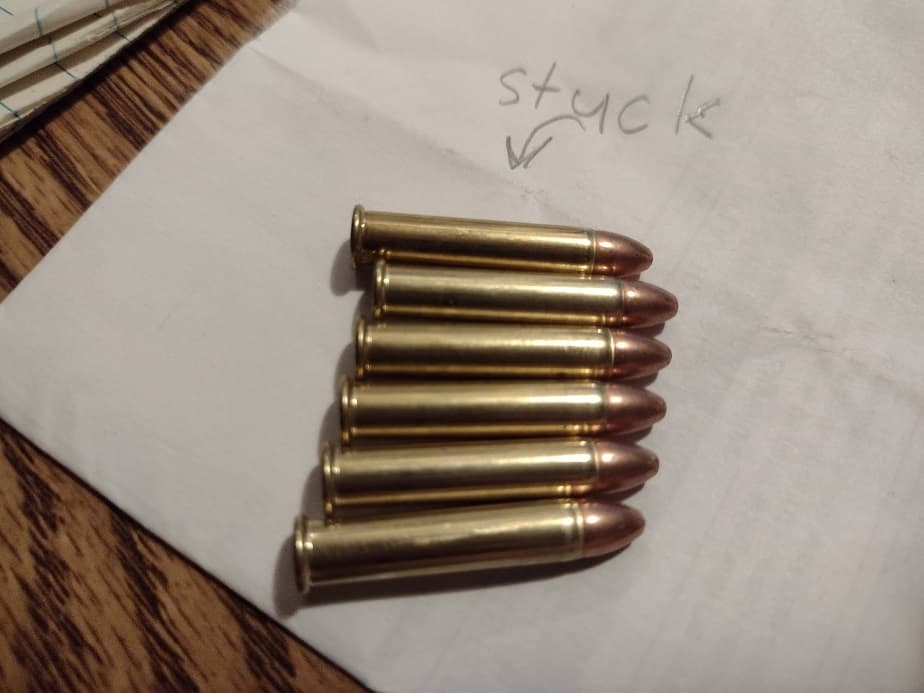7 Gun Models Notorious for Constantly Jamming
Kel Tec CP33 Magazine Causes Jamming
I rented a Kel Tec CP33 at a local range. The clerk asked for input on its performance because they had issues and the manufacturer sent them some new magazines as a fix. My sister-in-law and I had zero problems firing the CP33 at the shooting range. Apparently, the second factory run of mags runs smoother.
The magazine of the Kel Tex CP33 can jam if the magazine isn’t loaded properly. Improper loading creates rimlock, which is when the top cases’ rim is stuck behind the bullet beneath. The ammo won’t feed though and the gun jams. Some people just have a hard time loading the mags well. I don’t, but some do. I suppose it can be a learned finesse. They load different from most magazines and there can be a learning curve to learn how to do it right. I personally love the gun, but my buddy hates it. It is prone to jamming.

The CP33 is a 22lr pistol that looks like it belongs in a futuristic sci-fi action film complete with aliens and a damsel in distress. It’s a very large, very lightweight semi-automatic pistol that holds 33 rounds of 22lr in a sort of double or triple-ish stack magazine.
Traditional rules of gun-making say that 22lr doesn’t run well in handguns, it doesn’t like long magazines, and it can’t be double stacked in a magazine. But they did it. The factory beta testers ran the product nicely, with only the occasional minor complication. But they knew every intricacy of the gun.
The magazine was redesigned, and it helped a lot. Still, some people have a hard time loading the magazine perfectly, especially the last few rounds. The owner’s manual has a set of instructions and tips to avoid the issue, and the magazine is clear plastic so you can check it for issues before shooting.
Here is a video of the guys reviewing the CP33. I skipped it right to the part about reliability.
Diamondback DB380 Jams When it gets Dirty
Diamondback has been plagued by trouble. The DB380 is a cheap subcompact 380 pocket pistol. It’s teeny, accurate, and easy to handle. But, it doesn’t like to be dirty. That’s a problem for a pocket gun. If you actually carry a gun in your pocket, even in a pocket holster, it’s gonna get dirty.
The DB380 collects carbon buildup quickly while shooting, and it often starts to jam after a couple of boxes of range ammo. They are also a bit picky about ammo. It’s a challenge to make a sub-3-inch barreled semi-auto pistol function reliably well.
This gun is marketed as a personal protection gun. I wouldn’t trust my life to it. They just have a lot of bad apples with this model. I’ve heard and seen so many shooters having problems with this gun.
Cheap Quality of the Diamondback DB9 Causes Jamming
The DB9 has the same issues as the DB380. Poor quality control and cheap workmanship on a design that has very little margin for error. The DB9 is loathed at my local shooting range. They stopped selling them because of repeated issues with rental guns jamming.
Diamondback is a bottom dollar company that only really wants to make very cheap guns. They compete with Hi-Point but offer smaller, nicer-looking pistols. To quote a pastor friend of mine “ you can put a turd in a pretty box, but everybody knows it’s just a turd”. The Diamondback DB9 is made cheaply and is most likely to jam and cause you trouble.

The Remington RP9 is Poorly Made and Notorious for Jamming
Remington’s RP9 has poor workmanship, cheap construction, and lacks quality control. Remington thought they could simply slap together guns with cheap labor and shoddy materials and call it good. A lot of these were complete garbage.
Along with their poor workmanship and cheap construction, the parts of the Remington RP9 often don’t fit well. The slide rails often have burs or tooling marks, increasing friction and causing reliability issues. The Remington RP9s don’t run well when dirty and often jam. They leave a bad taste in your mouth. It’s a testament to a failed company, and why Remington went bankrupt twice in a few years.
The Century Ultra 87 is a Knock off Brand that Jams
The quality control on the Century Ultra 87 is, well I doubt there was any quality control. I tried several guns and the pump feels like it was milled with a Sawzall by an 8th grader in shop class. The metal is poorly firring, very rough, and incredibly soft. After shooting one round of skeet, I had problems starting.
The Century Ultra 87 is perhaps the most unreliable shotgun ever made. It’s a cheap Chinese copy of the Remington 870 pump-action. Trouble is, the 870 is already a cheap gun. These things sell for the price of a toaster, and honestly, the toaster is the better deal.
The entire bolt is too soft, the pump rail and guides are very flimsy, actually shearing metal off during use. The thing literally wants to jam. Note to self, don’t make a cheap copy of an already cheap gun.
Jamming of the Remington R-51 began after 175 Rounds
This gun launched Remington’s decline, and ultimately their first bankruptcy. It was a great concept with some new designs, but quality control went out the door during production. They were recalled and reengineered. The new ones are better; I have one. But they are still prone to jamming.
The R-51 is quite sensitive to limp-wristing, and is very fussy about cleanliness. After 175-200 rounds, mine will begin jamming on cue. It was better after a very long break-in period, but it’s still fussier than my 92-year-old grandmother about dirt, dust, and grime. They can be pretty picky with ammo too.
Preventing Jamming of the Sig Ultra-Compact 1911 is Possible
This is another one of those “going against the rules” guns. It’s very hard to make a 1911 in a compact package that runs well. Everything has to be timed perfectly and precisely and workable tolerance is almost non-existent. If it isn’t perfect, it won’t work. It’s a naturally fussy gun.
Reliability issues with Sig Ultra-Compact are commonplace, but fortunately can easily be fixed. And Sig will be glad to do it for you. It’s generally just a bit of polishing to loosen up a tight fit on the slide that will prevent jamming. These guns also need to be kept clean and oiled. There is no room for extra friction with a compact 1911.
They are also more sensitive to limp-wristing than most. You always need to have a good grip anyways, but a fussy gun does pose a reliability concern that must be considered.
